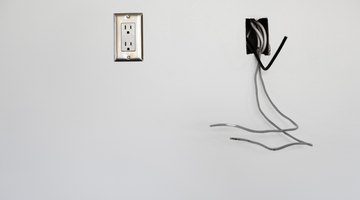How to Use a Non-Contact Voltage Tester
A non-contact voltage tester is one of the easiest and safest pieces of test equipment to use. Although used by the professional electrician, they were designed and engineered with the novice do-it-yourself electrician in mind.

Unlike conventional voltage testers, non-contact voltage testers don't require direct contact with live, current carrying conductors, thus exposing users to live voltage.
The non-contact voltage tester works by detecting the electromagnetic field that surrounds a current carrying conduct. This electromagnetic field radiates through space like radio waves and the tester intercepts them much as radio intercepts a radio signal.
-
Turn on the non-contact voltage tester on and bring it close to a known good receptacle. Now adjust the tester's sensitivity control so that the tester only responds when it touches the receptacle's cover plate.
-
Bring the non-contact voltage tester close to the faceplate of a malfunctioning receptacle and one of two things may happen. If it beeps, there's voltage; if it doesn't, there's no voltage present.
-
If the receptacle appears to be dead even though the non-contact tester beeps, the problem is that there's a break in the neutral conductor somewhere between that receptacle and the service panel.
-
If the non-contact tester doesn't give an audible or visual indication a voltage, there's a break in the hot wire somewhere between the non-functioning receptacle and the service panel--as long as the fuse hasn't blown or the circuit breaker tripped open.
-
Use the non-contact voltage tester to find a break in the knob-and-tube wiring system. The National Electric Code forbids using junction boxes that are concealed inside wall cavities, but with the old knob-and-tube wiring methods, splices made by soldering and taping were permitted inside finished ceilings, floors, and walls. Rodents have been known to eat through those wires, and those types of connections have been known to break from aging and tension, too.
-
Finding breaks in this wiring system can be a hit-and-miss proposition under the best conditions. There seems to be no rhyme or reason to the way they routed wires in those days, but you can use the non-contact voltage tester as a scan tool to find the first indication of a live wire in the problem area.
-
Use the non-contact voltage checker to check for a malfunctioning light switch. If you flip the switch and the light doesn't come on, even after you've replaced the bulb and checked the fuse and circuit breaker--and the non-contact voltage tester indicates voltage on one side of the switch but not the other--then you should suspect a bad switch.
-
As a rule, the cable bringing power from the service panel enters the bottom of the device box and the cable taking power to the light leaves the top. If you can read the field emanating from the bottom cable through the wall but no field from the top cable, suspect a bad switch.
References
Writer Bio
Based in Colorado Springs, Colo., Jerry Walch has been writing articles for the DIY market since 1974. His work has appeared in “Family Handyman” magazine, “Popular Science,” "Popular Mechanics," “Handy” and other publications. Walch spent 40 years working in the electrical trades and holds an Associate of Applied Science in applied electrical engineering technology from Alvin Junior College.
Photo Credits
- Jupiterimages/Brand X Pictures/Getty Images
- Jupiterimages/Brand X Pictures/Getty Images
More Articles



